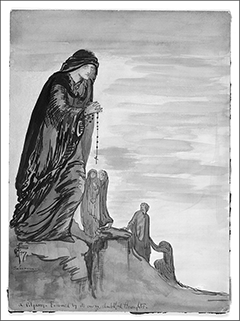Writing about Pamela, her life and times, and the tarot images that she created leaves behind a yearning to know what Pamela really did think and feel. Did she confront her deathbed with any regrets? We’ll never know unless in the future the “hidden diaries” of Pamela Colman Smith come to light. All we can do is to take what little information we have on her, what other people wrote about knowing her, and the art she created and use a little imagination and intuition!
It is said that when somebody comes to the end of their life, it is often the things they did not do that they regret, and we can say with some certainty that peoples’ last words are seldom “I wish I had made more money.” It is said of Pamela that she ended life in poverty, without the recognition she deserved; we can only wonder and surmise if this made her unhappy. It may be that she wished she had had more of a traditional family life, perhaps even her own children to share her world, something that would continue beyond her death. Pamela did not have any descendants to carry on her line; however, she left behind a legacy—a remembrance of her presence here on the earth—that will never die, seventy-eight cards that every day are used to enrich hundreds of life stories.
She has given us a tool to tell stories, and as a storyteller herself she would have enjoyed the unending stories created from her vision.
Waite
Waite would no doubt smile wryly knowing that out of the two most influential decks of the twentieth century, his became the most popular and arguably the most influential. It can be surmised that when Waite gave Pamela the proposition about designing the deck, he would have stressed that it was a spiritual tool, and she would have accepted the project knowing Waite was a Roman Catholic. The spiritual tool would aid one’s spirituality rather than cause it to degenerate. In later life we know that Waite interpreted the pip images Pamela had created, so this proved that he had not distanced himself from the deck to adhere to any religious guilt or rules. If this is so, there is no reason for Pamela to have disowned her tarot deck, unless of course Pamela was more devout than Waite.
We will leave the final words of this book to Pamela. As she saw her favoured Symbolist and Arts & Craft movements becoming obsolete, ahead of the two world wars that would dismantle any hope of a better future, she railed against the lack of inspiration caused by the “the incessant roar of high-power presses.” She despaired of the suppression of individualism and the “prudishness and pompous falseness of a great mass of intelligent people.” There was only one power she thought ideal, and one quest—the return of charm and grace, the charm and grace she was to capture forever in her seventy-eight images drawn in the summer of 1909. The year before, she wrote this:
Use your wits, use your eyes. Perhaps you use your physical eyes too much and only see the mask. Find eyes within, look for the door into the unknown country.
“High over cap” on a fairy horse—ride on your Quest—for what we are all seeking—Beauty. Beauty of thought first, beauty of feeling, beauty of form, beauty of color, beauty of sound, appreciation, joy, and the power of showing it to others.
—Pamela Colman Smith’s personal correspondances
